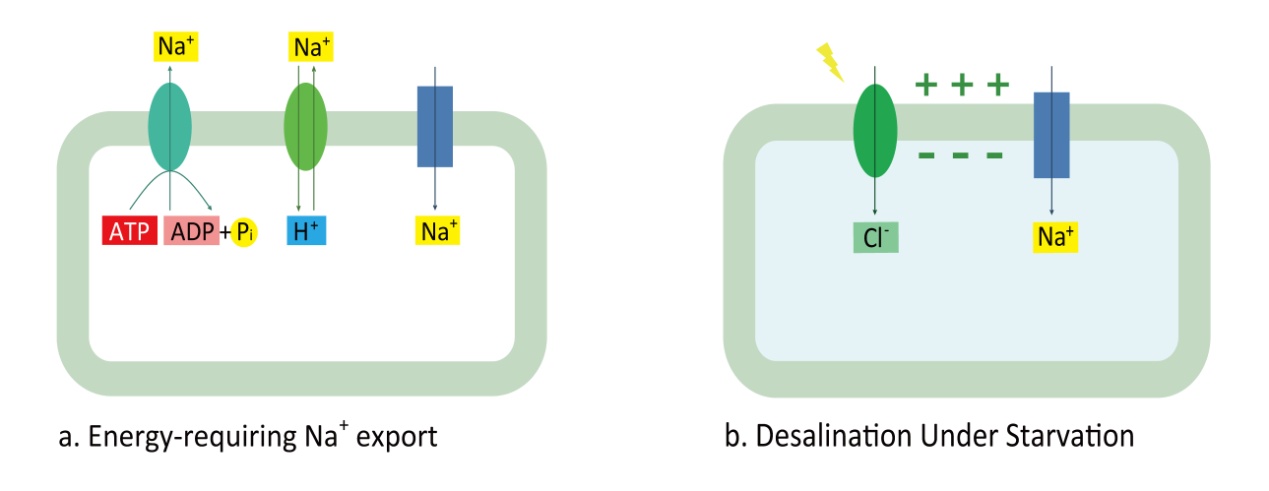Design
Design of transport module
Halorhodopsin (HR) proteins are light-driven inward-directed chloride pumps from halobacteria. They are membrane-integral proteins of the rhodopsin superfamily that form a covalent bond with the carotenoid-derived chromophore all-trans retinal. Absorption of a photon with a defined optimal wavelength induces trans-cis isomerization of retinal, which triggers a catalytic photocycle of conformational changes in the protein, resulting in the net import of one chloride per photon into the cytoplasm.[1] And its electrophysiological properties have been characterized in Xenopus laevis oocytes.[2] We use it as our biodesalination driver which confers cyanobacteria the ability to absorb chloride to a significant degree.
As for sodium, cyanobacteria can actively export sodium ions to maintain low internal sodium concentration under saline conditions and Na+/H+ antiporter performs the majority of Na+ extrusion, which requires ATP as the energy source. And the ATP requirement provide opportunity to halt sodium export by depleting internal ATP stores. Manipulation of cultivation conditions such as omitting photosynthetically efficient wavelengths from the light spectrum may deplete nutrient supply and exhaust ATP reserves. Moreover, we propose that the negative membrane potential generated by halorhodopsin would drive the influx of cation through sodium ion channels.
(Figure)
Design of control system ——PcpcG2 and Pdark
Light-inducible and heavy metal inducible promoters are the main biological switches in synthetic biology of cyanobacteria. Considering that our ultimate goal is to obtain an engineered organism capable of extracting sodium chloride from seawater without leaving any harmful substance, candidate promoters should meet a few key criteria. Firstly, the inducing condition shouldn’t leave any harmful substance that is difficult to remove. Secondly, the inducing condition shouldn’t cost too much if applied to industrial scale. Thirdly, the inducing condition should be compatible with starvation. Based on these conditions, we selected two light-inducible promoters which are described in the following paragraphs.
The control of PcpcG2 over downstream gene is based on the CcaS-CcaR-PcpcG2 system identified in PCC 6803(showed in Figure 1), which has been characterized and further engineered to be a useful genetic tool [1]. The phycobilisome linker gene cpcG2 is chromatically regulated by the sensor histidine kinase CcaS and cognate response regulater CcaR. CcaS catalyzes antophosphorylation followed by phototransfer to CcaR under green light and dephosphorylation under red light [2]. Simply put, the expression of cpcG2 is induced by green light and inhibited by red light.
Figure 1.2.1 Green light sensing expression system.
CcaS phosphorylates CcaR under green light and phosphorylated CcaR binds to promoter of cpcG2 to induce expression of cpcG2.
Red light and green light requires artificial illumination or extensive light filter, which may cause difficulty in scaling up biodesalination process. We searched for another promote that allows the process to rely only on natural light and darkness. And Pdark, which is from previous iGEM team (BBa_K1026009), was our answer. This “dark-sensing” promoter combines PcpcG2 and a constitutive promoter from Ecoli and it can be regarded as the “reverse PcpcG2”. The Pdark is inhibited by green-light and activated by darkness and the design idea can be seen in https://2013.igem.org/Team:SJTU-BioX-Shanghai/Project/Light_sensor/Greeen .
Design of biodesalination process
The cultivation of engineered cyanobacteria comprises three phases: growth phase, expression phase and desalination phase. After cyanobacteria reaching a high density, we induce the expression of halorhodopsin, and subsequently we move the cyanobacteria into white-light condition afterwards, which allows the halorhodopsin to work.
Based on PcpcG2 and HR, we established a biodesalination system which relies on red and green light. The light color in the three stages are red light, green light and white light respectively. In the growth stage, red light is enough for photosynthesis of cyanobacteria and we determined the curve under red light (seen in the Experiment and Results section). In the induced expression stage, the green light induces the expression of HR. Additionally, green light can’t provide energy source for chlorophyll, thus creating a starvation condition. In the working stage, halorhodopsin absorbs light to drive chloride import.
Based on Pdark and HR, we constructed an improved biodesalination system which depends only on the switch between white light and darkness. In the growth stage and working stage, we provide white light while in the induced expression stage we remove the light source. Moreover, if the induced expression stage is as long as the night, this improved biodesalination system can be control by the normal changes between day and night without any human intervention.
(Figure)






